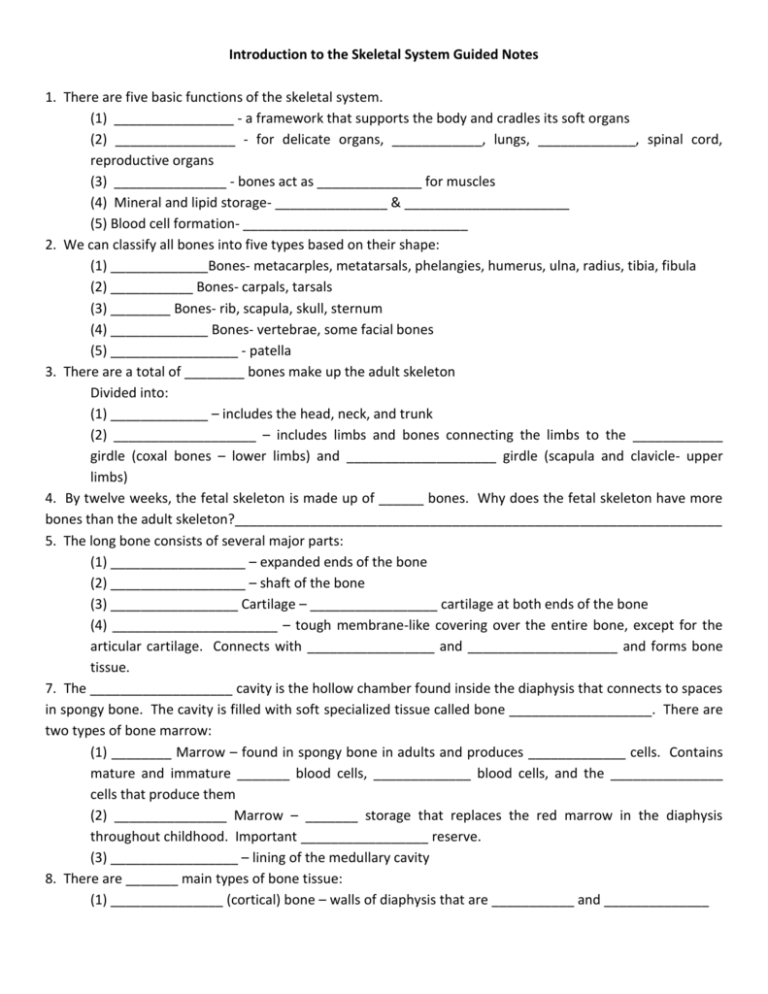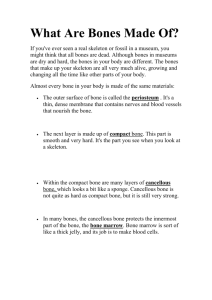File
advertisement

Introduction to the Skeletal System Guided Notes 1. There are five basic functions of the skeletal system. (1) ________________ - a framework that supports the body and cradles its soft organs (2) ________________ - for delicate organs, ____________, lungs, _____________, spinal cord, reproductive organs (3) _______________ - bones act as ______________ for muscles (4) Mineral and lipid storage- _______________ & ______________________ (5) Blood cell formation- ______________________________ 2. We can classify all bones into five types based on their shape: (1) _____________Bones- metacarples, metatarsals, phelangies, humerus, ulna, radius, tibia, fibula (2) ___________ Bones- carpals, tarsals (3) ________ Bones- rib, scapula, skull, sternum (4) _____________ Bones- vertebrae, some facial bones (5) _________________ - patella 3. There are a total of ________ bones make up the adult skeleton Divided into: (1) _____________ – includes the head, neck, and trunk (2) ___________________ – includes limbs and bones connecting the limbs to the ____________ girdle (coxal bones – lower limbs) and ____________________ girdle (scapula and clavicle- upper limbs) 4. By twelve weeks, the fetal skeleton is made up of ______ bones. Why does the fetal skeleton have more bones than the adult skeleton?_________________________________________________________________ 5. The long bone consists of several major parts: (1) __________________ – expanded ends of the bone (2) __________________ – shaft of the bone (3) _________________ Cartilage – _________________ cartilage at both ends of the bone (4) ______________________ – tough membrane-like covering over the entire bone, except for the articular cartilage. Connects with _________________ and ____________________ and forms bone tissue. 7. The ___________________ cavity is the hollow chamber found inside the diaphysis that connects to spaces in spongy bone. The cavity is filled with soft specialized tissue called bone ___________________. There are two types of bone marrow: (1) ________ Marrow – found in spongy bone in adults and produces _____________ cells. Contains mature and immature _______ blood cells, _____________ blood cells, and the _______________ cells that produce them (2) _______________ Marrow – _______ storage that replaces the red marrow in the diaphysis throughout childhood. Important _________________ reserve. (3) _________________ – lining of the medullary cavity 8. There are _______ main types of bone tissue: (1) _______________ (cortical) bone – walls of diaphysis that are ___________ and ______________ (2) _________________ (cancellous) bone – found in epiphysis and covered with a thin layer of compact bone. Has many branching, bony “______________” 9. _________________ are mature bone cells. 10. There are several components to the bone cell: *Osteocytes are enclosed in tiny chambers called ___________________ and form a concentric ring (layers) around a passageway called the ___________________ canal. *Thin layers of bone matrix are called ___________________ *Osteocytes are connected by minute branches called _____________________ that allow nutrient transfer and osteocyte communication. *Haversian canals are connected by passages called _________________________ canals, that contain blood vessels and nerve fibers. *Except at joints, the outer surfaces of bones are covered by a _______________________ layer. *Circular layers of matrix and osteocytes along with the haversian canal make up a unit called the __________________ (haversian system)








